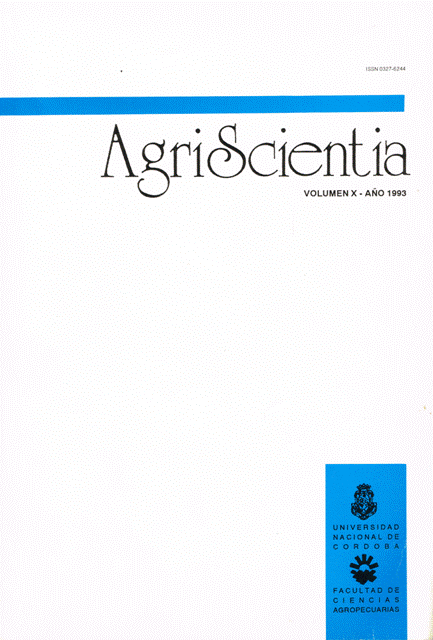Senescencia en hojas de Avena sativa cv. Suregrain. Efecto de bloqueantes del metabolismo energético
Contenido principal del artículo
Resumen
En este trabajo se analiza la relación entre el agregado de sustancias bloqueantes del metabolismo energético, cambios en permeabilidad y nivel de oxidaciones celulares. Como sistema experimental in vitro, los segmentos foliares de hojas de Avena sativa cv. Suregrain fueron incubados previamente durante 4 hs. en oscuridad con bloqueantes del metabolismo energético como DCMU, KCN, DNP,EDTA y Tritón X-100. Los resultados muestran que todos los bloqueantes ensayados aumentaron los síntomas de senescencia medidos como cambios en permeabilidad, degradación de clorofilas y proteólisis; apoyando la idea de una relación entre disminución de la energía y aceleración de la senescencia. El hecho de que el uso de los bloqueantes del metabolismo energético fuera acompañado por un estímulo en el contenido de MDA, sugiere que el efecto de la disminución del metabolismo energético estaría mediado por un aumento en el nivel de oxidaciones celulares. Además, dado que cisteína, sustancia protectora de grupos SH, retardó la evolución de todas las variables en estudio, sugiere que el daño por oxidaciones implicaría un ataque a grupos SH de proteínas celulares.
Detalles del artículo

Esta obra está bajo una licencia internacional Creative Commons Atribución-CompartirIgual 4.0.
Cómo citar
Referencias
Arnon, D.I., & Chain, R.K. (1975). Regulation of ferredoxin-catalyzed photosynthetic phosphorylation. Proceedings of the National Academy of Sciences USA, 72, 4961-4965.
Arntzen, C.J., Darr, S.C., Mullat, J.E., Steinback, K.E., & Pfister, K. (1982). Polypeptid determinants of plastoquinone function in photosystem II of chloroplasts. In B.L. Trumpower (Ed.), Function of quinones in energy conserving systems (pp. 443-452). New York: Academic Press.
Avron, M. (1981). Photosynthetic electron transport and photophosphorylation. In M.D. Hatch & N.K. Boardman (Eds.), The Biochemistry of plants: Photosynthesis (pp. 163-191). New York: Academic Press.
Dean, R.T., & Pollak, J.K. (1985). Endogenous free radical generation may influence proteolysis in mitochondria. Biochemical and Biophysical Research Communications, 126(3), 1082-1089.
Enami, J., & Kura-Hotta, M. (1984). Effect of intracellular ATP levels on the light-induced H+ efflux from intact cells of Cyanidium caldarium. Plant and Cell Physiology, 25(7), 1107-1113.
Hachimori, A., Nosoh, Y., & Sone, N. (1968). Effects of the photosynthetic inhibitors on the respiration of yeast mitochondria. Journal of Biochemistry Tokyo, 64, 119-121.
Heath, R.L., & Packer, L. (1968). Photoperoxidation in isolated chloroplasts: I. Kinetics and stoichiometry of fatty acid peroxidation. Archives of Biochemistry and Biophysics, 125, 189-198.
Jagendorf, A.T. (1977). Photophosphorylation. In A. Trebst & M. Avron (Eds.), Photosynthesis (pp. 307-336). New York: Springer Verlag.
Jeanjean, R. (1976). The effect of metabolic poisons on ATP level and on active phosphate uptake in Chlorella pyrenoidosa. Physiologia Plantarum, 37, 107-110.
Kinraide, T.B., & Etherton, B. (1982). Energy coupling in H+, amino acid cotransport. Plant Physiology, 69, 648-652.
Luna, C.M., & Trippi, V.S. (1986). Membrane permeability: Regulation by exogenous sugars during senescence of oat leaf in light and darkness. Plant and Cell Physiology, 27, 1051-1062.
Malik, N.S.A., & Thimann, K.V. (1980). Metabolism of oat leaves during senescence: VI. Changes in ATP levels. Plant Physiology, 65, 855-858.
Moreland, D.E. (1980). Mechanisms of action of herbicides. Annual Review of Plant Physiology, 31, 597-638.
Moore, S., & Stein, W.H. (1948). Photometric ninhydrin method for use in the chromatography of amino acids. Journal of Biological Chemistry, 176, 367-388.
Murphy, T.M. (1984). Effect of sulfhydryl reagents on K+ efflux from rose cells. Plant Physiology, 75, 138-141.
Renger, G. (1973). The action of 3-(3,4-dichlorophenyl)-1,1-dimethylurea on the water-splitting enzyme system of photosynthesis. Biochimica et Biophysica Acta, 314, 113-116.
Sailer, S.O., & Thimann, K.V. (1980). The influence of aliphatic alcohols on leaf senescence. Plant Physiology, 66, 395-399.
Solomos, T. (1977). Cyanide-resistant respiration in higher plants. Annual Review of Plant Physiology, 28, 279-297.
Tetley, R.M., & Thimann, K.V. (1974). The metabolism of oat leaves during senescence: I. Respiration, carbohydrate metabolism and the action of cytokinins. Plant Physiology, 54, 294-303.
Trippi, V.S., & Thimann, K.V. (1983). The exudation of solutes during senescence of oat leaves. Physiologia Plantarum, 58, 21-28.
Trippi, V.S., & Paulin, A. (1984). The senescence of cut carnations: A phasic phenomenon. Physiologia Plantarum, 60, 221-226.
Trippi, V.S., & De Luca d'Oro, G.M. (1985). The senescence process in oat leaves and its regulation by oxygen concentration and light irradiance. Plant and Cell Physiology, 26(7), 1303-1311.
Trippi, V.S., Paulin, A., & Pradet, A. (1988). Effect of oxygen concentration on the senescence and energy metabolism of cut carnation flowers. Physiologia Plantarum, 73, 374-379.
Trippi, V.S., Gidrol, X., & Pradet, A. (1989). Effects of oxidative stress caused by oxygen and hydrogen peroxide on energy metabolism and senescence in oat leaves. Plant and Cell Physiology, 30(2), 157-162.
Woolhouse, H.W. (1984). The biochemistry and regulation of senescence in chloroplasts. Canadian Journal of Botany, 62, 2934-2942.





